What is the sealing mechanism used in a butterfly valve?
The sealing mechanism used in a butterfly valve is typically achieved through a combination of two mechanisms: line contact and interference fit.
Line Contact: The primary sealing mechanism in a butterfly valve is line contact. This means that when the valve is in the closed position, the disc (or “butterfly”) makes a line contact with the seat, creating a sealing line along the circumference of the disc. The line contact ensures that there is a tight seal to prevent fluid from flowing past the closed valve.
Interference Fit: In addition to line contact, interference fit is another sealing mechanism used in butterfly valves. When the valve is closed, the disc is pressed against the seat by the pressure of the fluid, creating an interference fit. The interference fit adds to the sealing effectiveness by enhancing the sealing line contact between the disc and the seat.
The combination of line contact and interference fit helps to achieve a tight seal and prevent leakage when the butterfly valve is in the closed position. The effectiveness of the sealing mechanism depends on various factors such as the design of the valve, the materials used for the disc and seat, and the applied pressure.
It’s worth noting that different types of butterfly valves, such as concentric, double-offset, and triple-offset valves, may have variations in their sealing mechanisms. For example, triple-offset butterfly valves often use a metal-to-metal sealing mechanism, where the disc makes an offset contact with the seat to ensure a tight seal. The specific sealing mechanism can vary depending on the design and intended application of the butterfly valve.
How are butterfly valves actuated or operated (manually or automatically)?
Butterfly valves can be actuated or operated either manually or automatically, depending on the specific application and control requirements.
Here are the two primary methods of actuation:
Manual Actuation: In manual actuation, the butterfly valve is operated by hand or using a manual lever or gear mechanism. The operator physically turns the lever or gear to open or close the valve. Manual actuation is commonly used in applications where the valve needs to be operated infrequently, or where precise control is not necessary. ductile iron wafer butterfly valve Manual actuation is generally more cost-effective and simpler compared to automated actuation.
Automatic Actuation: In automatic actuation, the butterfly valve is operated by an actuator, which can be electric, pneumatic, or hydraulic. The actuator receives signals from a control system or process instrumentation and automatically adjusts the valve position based on the desired control parameters. Automatic actuation is suitable for applications that require frequent and precise control, remote control, or integration with a larger control system. The type of actuator chosen depends on factors such as the available power source, control system compatibility, and the specific requirements of the application.
a. Electric Actuation: Electric actuators use an electric motor to open or close the valve. Electric actuators are commonly used when there is a stable power supply available and when precise control and positioning are required. They can be easily integrated into control systems and offer features such as feedback signals and remote control options.
b. Pneumatic Actuation: Pneumatic actuators use compressed air or gas to operate the valve. Air pressure is used to open or close the valve, and the actuator’s design allows for precise control and quick response. Pneumatic actuators are often used in applications where compressed air is readily available, and rapid actuation is required.
c. Hydraulic Actuation: Hydraulic actuators use pressurized hydraulic fluid to operate the valve. The hydraulic fluid is controlled to open or close the valve, offering precise control and high force capabilities. Hydraulic actuators are typically used in applications where high operating pressures or heavy-duty operation is required.
The choice between manual and automatic actuation depends on factors such as the required level of control, the frequency of operation, the complexity of the control system, and the specific needs of the application.

